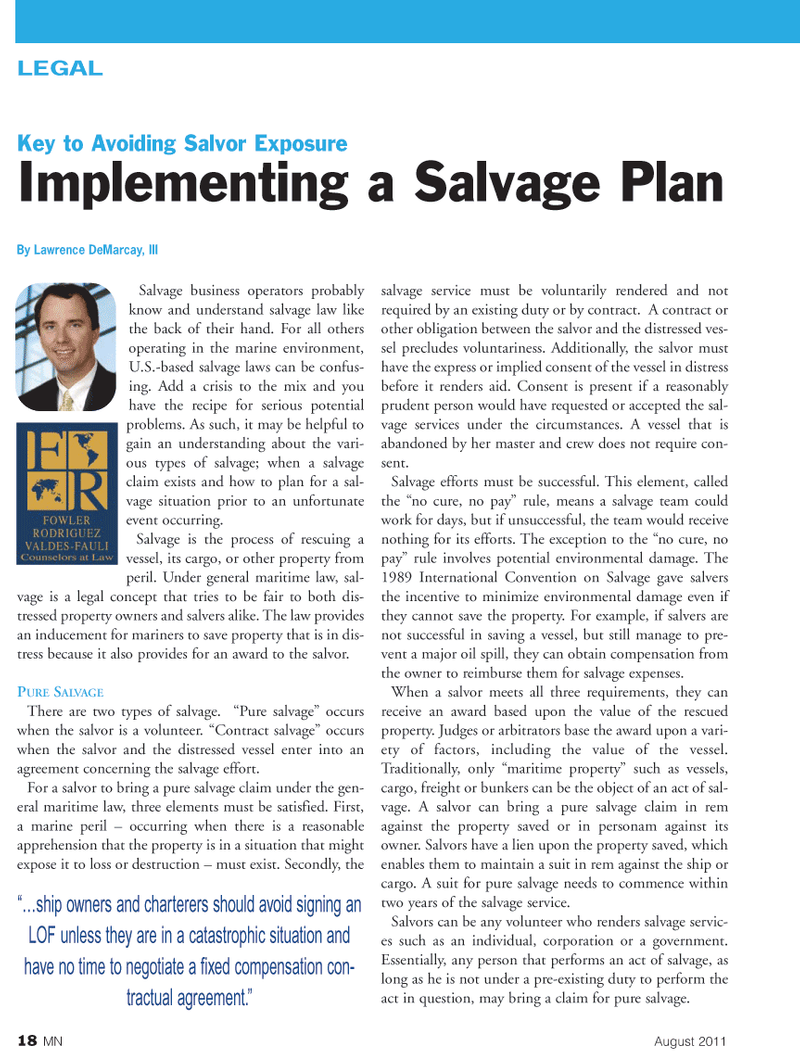
Page 18: of Marine News Magazine (August 2011)
Marine Salvage & Recovery Edition
Read this page in Pdf, Flash or Html5 edition of August 2011 Marine News Magazine
18MNAugust 2011LEGALSalvage business operators probably know and understand salvage law like the back of their hand. For all others operating in the marine environment, U.S.-based salvage laws can be confus- ing. Add a crisis to the mix and you have the recipe for serious potential problems. As such, it may be helpful to gain an understanding about the vari- ous types of salvage; when a salvage claim exists and how to plan for a sal- vage situation prior to an unfortunate event occurring. Salvage is the process of rescuing a vessel, its cargo, or other property from peril. Under general maritime law, sal- vage is a legal concept that tries to be fair to both dis- tressed property owners and salvers alike. The law provides an inducement for mariners to save property that is in dis- tress because it also provides for an award to the salvor. PURESALVAGE There are two types of salvage. Pure salvage? occurs when the salvor is a volunteer. Contract salvage? occurs when the salvor and the distressed vessel enter into an agreement concerning the salvage effort. For a salvor to bring a pure salvage claim under the gen- eral maritime law, three elements must be satisfied. First, a marine peril ? occurring when there is a reasonable apprehension that the property is in a situation that might expose it to loss or destruction ? must exist. Secondly, the salvage service must be voluntarily rendered and not required by an existing duty or by contract. A contract or other obligation between the salvor and the distressed ves- sel precludes voluntariness. Additionally, the salvor must have the express or implied consent of the vessel in distress before it renders aid. Consent is present if a reasonably prudent person would have requested or accepted the sal- vage services under the circumstances. A vessel that is abandoned by her master and crew does not require con- sent.Salvage efforts must be successful. This element, called the no cure, no pay? rule, means a salvage team could work for days, but if unsuccessful, the team would receive nothing for its efforts. The exception to the no cure, no pay? rule involves potential environmental damage. The 1989 International Convention on Salvage gave salvers the incentive to minimize environmental damage even if they cannot save the property. For example, if salvers are not successful in saving a vessel, but still manage to pre- vent a major oil spill, they can obtain compensation from the owner to reimburse them for salvage expenses. When a salvor meets all three requirements, they can receive an award based upon the value of the rescued property. Judges or arbitrators base the award upon a vari- ety of factors, including the value of the vessel. Traditionally, only maritime property? such as vessels, cargo, freight or bunkers can be the object of an act of sal- vage. A salvor can bring a pure salvage claim in rem against the property saved or in personam against its owner. Salvors have a lien upon the property saved, which enables them to maintain a suit in rem against the ship or cargo. A suit for pure salvage needs to commence within two years of the salvage service. Salvors can be any volunteer who renders salvage servic- es such as an individual, corporation or a government. Essentially, any person that performs an act of salvage, as long as he is not under a pre-existing duty to perform the act in question, may bring a claim for pure salvage. Key to Avoiding Salvor Exposure Implementing a Salvage PlanBy Lawrence DeMarcay, III ?ship owners and charterers should avoid signing an LOF unless they are in a catastrophic situation and have no time to negotiate a fixed compensation con- tractual agreement.?

 17
17

 19
19
